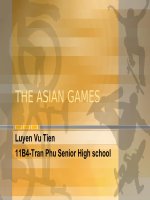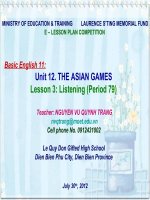Unit 12 The Asian GamesReading
Bạn đang xem bản rút gọn của tài liệu. Xem và tải ngay bản đầy đủ của tài liệu tại đây (1.56 MB, 33 trang )
<span class='text_page_counter'>(1)</span>Congratulation on International Women’s Day!.
<span class='text_page_counter'>(2)</span> THE ASIAN GAMES Unit 12. Part A: Reading.
<span class='text_page_counter'>(3)</span> I. Warm up :. Activity 1: Look at the following pictures and tell the names of the sports..
<span class='text_page_counter'>(4)</span> a. d. Volleyball. Boxing. b. e. Bodybuilding. Karatedo. Rugby. c. f. Fencing.
<span class='text_page_counter'>(5)</span> I. Warm up :. Activity 2: Look at the following pictures and guess the names of the sports..
<span class='text_page_counter'>(6)</span> What kind of sports is this?. football.
<span class='text_page_counter'>(7)</span> What kind of sports is this?. bodybuilding.
<span class='text_page_counter'>(8)</span> What kind of sports is this?. basketball.
<span class='text_page_counter'>(9)</span> What kind of sports is this?. mountain biking.
<span class='text_page_counter'>(10)</span> What kind of animals is the mascot (linh vật) of 15th Asian Games in 2006?. goat.
<span class='text_page_counter'>(11)</span> Where is this?. Asia.
<span class='text_page_counter'>(12)</span> Unit 12:. The Asian Games. Reading (P136).
<span class='text_page_counter'>(13)</span> II. Berore you read. Choose the correct answer. 1. How often are the Asian games held? A. 4 years A.. B. 5 years. C. 6 years. 2. What sports is Vietnam best at ? A. Bodybuilding. B.Women’s karatedo C. A & B. 3. Where were the first Asian Games held? A. China. B. B India. C. Korea.
<span class='text_page_counter'>(14)</span> Before-reading: Open your book and listen. The Asian Games, which take place every four years, are held for the purpose of developing intercultural knowledge and friendship within Asia. In this multi-sport event, young people from all over Asia gather together to compete. It is an occasion when strength and sports skills are tested; friendship and solidarity are built and promoted. During their five-decade history, the Asian Games have been advancing in all aspects. The number of participants has been increasing. The quality of athletes, officials and sports facilities has also been developing through time. New sports and traditional sports have been introduced and added to the Games. The 1st Asian Games were held in New Delhi, India in 1951. Only 489 athletes from 11 nations took part in the Games. The six sports events at the first Games were basketball, cycling, football, aquatic sports, athletics and weightlifting. Boxing, shooting and wrestling were added at the 2 nd Asian Games in Manila, the Philippines in 1954; and tennis, volleyball, table tennis and hockey were added at the 3rd Asian Games in Tokyo, Japan in 1958. Squash, rugby ,fencing and mountain biking were introduced for the first time at the 13th Asian Games in Bangkok, Thailand in 1998. The 14th Asian Games, which were held in Busan, Korea in 2002, attracted 9,919 participants from 44 countries. The athletes competed in 38 different sports and won 427 gold medals. The Vietnamese participants took part in this event with great enthusiasm. Their efforts were much appreciated when they won 2 gold medals in bodybuilding and billiards, and 2 others in women’s karatedo. It is hoped that in the near future, Vietnam will become a host country and receive more medals in a variety of sports events..
<span class='text_page_counter'>(15)</span> Vocabulary 1. intercultural (adj) /intə'kʌlt∫ərəl/ 2. solidarity (n) /sɔli'dærəti/ 3. advance (v,n) /əd'va:ns/ 4. facility (n) /fə'siləti/ 5. athlete (n) /'æθli:t/ 6. aquatic (adj) /ə'kwætik/ 7. appreciate (v) /ə'pri:∫ieit/ 8. enthusiasm (n) /in'θju:ziæzm/ 9. effort (n) /'efət/.
<span class='text_page_counter'>(16)</span> • Match a word in column A with its meaning in column B. A B 1. intercultural (a) a. đồ dùng tiện nghi 2. solidarity (n) b. đánh giá cao 3. enthusiasm (n) c. liên văn hoá 4. facility (n) d. vận động viên điền kinh 5. aquatic (a) e. sự nhiệt tình 6. appreciate (V) f. dưới nước 7. advance (v) g. sự nỗ lực 8. athlete (n) h. tình đoàn kết 9. effort (n) i. tiến bộ. 1c , 2h, 3e, 4a, 5f, 6b, 7i, 8d, 9g.
<span class='text_page_counter'>(17)</span> III. While you read. Task 1: Fill each blank with a suitable word Task 2: Scan the passage and complete the table Task 3: Answer the questions.
<span class='text_page_counter'>(18)</span> The Asian Games: Reading The Asian Games, which take place every four years, are held for the purpose of developing intercultural knowledge and friendship within Asia. In this multi-sport event, young people from all over Asia gather together to compete. It is an occasion when strength and sports skills are tested; friendship and solidarity are built and promoted. During their five-decade history, the Asian Games have been advancing in all aspects. The number of participants has been increasing. The quality of athletes, officials and sports facilities has also been developing through time. New sports and traditional sports have been introduced and added to the Games. The 1st Asian Games were held in New Delhi, India in 1951. Only 489 athletes from 11 nations took part in the Games. The six sports events at the first Games were basketball, cycling, football, aquatic sports, athletics and weightlifting. Boxing, shooting and wrestling were added at the 2nd Asian Games in Manila, the Philippines in 1954; and tennis, volleyball, table tennis and hockey were added at the 3rd Asian Games in Tokyo, Japan in 1958. Squash, rugby ,fencing and mountain biking were introduced for the first time at the 13th Asian Games in Bangkok, Thailand in 1998. The 14th Asian Games, which were held in Busan, Korea in 2002, attracted 9,919 participants from 44 countries. The athletes competed in 38 different sports and won 427 gold medals. The Vietnamese participants took part in this event with great enthusiasm. Their efforts were much appreciated when they won 2 gold medals in bodybuilding and billiards, and 2 others in women’s karatedo. It is hoped that in the near future, Vietnam will become a host country and receive more medals in a variety of sports events..
<span class='text_page_counter'>(19)</span> Task 1: Scan the passage. Fill each blank with a suitable word effort. appreciated facilities enthusiasm advancing aquatic. 1. The hotel has special ___________ for disabled athletes 2. Swimming and water skiing are both ____________ sports. 3. He never lost his _____________ for training athletes. 4. I will make every ______________ to arrive on time. 5. Our sport performances have been ____________ considerably over recent years. 6. Your help was greatly _____________..
<span class='text_page_counter'>(20)</span> Task 2: Scan the passage and complete the following table. Year Events st (1) The 1 Asian games began in New 1951 _____ Delhi, India. Boxing, shooting and wrestling were nd The 2 Asian Games in Manila, the 1954 added at (2) Philippines . _________________________________. 1958 Tennis, volleyball, table tennis and (3) rd hockey Squash, were added the 3and Asian rugby _____ Games held in Tokyo, Japan. mountain biking (4) __________________________ were 2002 1998 introduced at the 13th Asian Games in Bangkok, Thailand..
<span class='text_page_counter'>(21)</span> Task 3: Answer the questions: 1. What is the purpose of the Asian Games? 2. How many participants took part in the 14th Asian Games? 3. In which sports events did the Vietnamese athletes win gold medals at the Busan Games?.
<span class='text_page_counter'>(22)</span> 1. What is the purpose of the Asian Games? To. develop intercultural knowledge and friendship within Asia.. 2. How many participants took part in the 14th Asian Games?. 9,919 (participants). 3. In which sports events did the Vietnamese athletes win gold medals at the Busan Games?. In bodybuilding, billiards and women’s karatedo..
<span class='text_page_counter'>(23)</span> IV. AFTER YOU READ:.
<span class='text_page_counter'>(24)</span> 1. Choose the best answer. 1. How many sport events were there at the 3rd Asian Games? A. 6 B. 8 C.9 D.13 D 2. In which year did the 6th Asian Games take place? A. 1966 B.1970 B C.1974 D.1962 3. Which sport people could NOT see at the 2nd Asian Games? A. Football B. Fencing B C. Cycling D. Boxing.
<span class='text_page_counter'>(25)</span> 2. What is the text mainly about? A. Preparation for the Asian Games. B. Developing history of Asian Games. C. Purpose of Asian Games. D. Sports events at the Asian Games..
<span class='text_page_counter'>(26)</span> 3. Match the people in the pictures with their names and their sports..
<span class='text_page_counter'>(27)</span> Name 1. Lý Đức 2. Vũ Thị Nguyệt Ánh 3. Lê Công Vinh 4. Thúy Hiền. 1. 2. 3. 4. Sport a. Football b. Bodybuilding c. Karatedo d. Wushu.
<span class='text_page_counter'>(28)</span> 1. Lý Đức b. Bodybuilding.
<span class='text_page_counter'>(29)</span> 2. Vũ Thị Nguyệt Ánh. C.Karatedo.
<span class='text_page_counter'>(30)</span> 3. Lê Công Vinh. d. Football.
<span class='text_page_counter'>(31)</span> 2. Thuý Hiền. d. Wushu.
<span class='text_page_counter'>(32)</span> Unit 12: The Asian Games A. Reading. Homework Write a summary within ( 70-100 words) about the history of the Asian Games. Prepare for Speaking section, Unit 12..
<span class='text_page_counter'>(33)</span> Thank you. Good bye and See you again !.
<span class='text_page_counter'>(34)</span>









